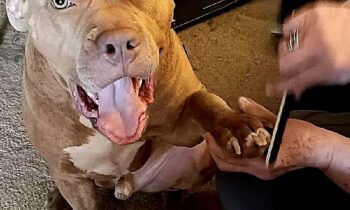
Eileen Anderson, author of Remember Me?, a guidebook for owners of dogs who are losing their mental faculties as they age, is with us again this week to answer questions about canine cognitive dysfunction.
Val Hughes: I’m curious as to your take on “best-case scenarios” with CCD. In your experience, are there certain owners who are most likely to succeed in caring for dogs with CCD—for example, individuals without young children or elderly parents at home, self-employed persons who work from home or in a pet-friendly office, people with enough extra income to hire help?
Eileen Anderson: I base my observations on the hundreds of people who have commented on my website, as well as others I have talked to in different capacities. Certainly having the means to make adaptations to one’s home or hire assistance can help, as well as having a support system of family and friends. But I believe that the owners who succeed and cope the best have some personal characteristics in common.
- Stamina. Taking care of a dog with dementia can be emotionally and physically taxing, especially if the dog is a night wanderer or barker.
- Adaptability. The dog’s needs are changing as he grows older and the disease worsens .The successful caregiver is a flexible problem solver and willing to compromise her own home environment. Dog can’t get traction on the floor? Try different boots or nail covers or floor coverings. Dog is at risk of falling down some stairs? Be willing to install a gate. Dog is incontinent? Experiment with diapers, pee pads, and different floor coverings until you get the optimal combination.
- Empathy more than sympathy. Sometimes I feel like I’m on a one-woman crusade to promote empathy. We tend to have an uncontrollable surge of sympathy when we see our formerly sharp and active dog walking in circles, standing in corners, or doing various other loopy things.
When I show videos of my little Cricket pacing around—with no visible anxiety, just trucking along—the common reaction is, “Poor baby!” That’s sympathy. People are responding emotionally to what they see as a pathetic or even tragic situation. But in many cases, the dog is probably not suffering. If we can put ourselves in our dog’s situation, be empathetic, it helps us better assess their quality of life.
Wandering doesn’t always mean being lost or miserable. Zoning out in a corner may not be any worse than snoozing on a mat. I don’t mean to sugarcoat. Some dogs with dementia are in bad shape with anxiety and painful confusion. But I see the people who can assess their dog’s new world without reference to who the dog “used to be” as being more successful caregivers with less emotional turmoil.
In my book I discuss anogsonosia. This is the situation of being unaware that one is ill. It is actually a clinical symptom of human Alzheimer’s, and I think dogs are in a similar situation in their doggie way. They probably don’t know they are impaired. If we can get that in our heads, we can rest more easily.

Photo by Hilary Lane
Val Hughes: Certainly, there must be situations in which caring in one’s home for a dog with CCD is simply not a practical possibility. It could be due to lack of finances, time, or support from friends or family. It could be because of the owner’s physical limitations; lack of strength or balance, for example. It could be because the residence in which the dog and owner live makes suggested care impossible—too many stairs, or elevator-access only. It could be because the humans in the dog’s life are emotionally unable to face the daily surprises and set-backs without suffering from high anxiety themselves. What are your suggestions for folks who must figure out, “Can we care for our dog with CCD? And what do we do if we’re not sure what we can handle?”
Eileen Anderson: This is almost unbearably sad to think about. Dogs with CCD do get taken to shelters now and then, of course. I have learned from my friends who work in shelters never to offhandedly condemn people taking their family dogs to shelters. Many of these are loved dogs and we just don’t know the tragedy behind the scenes. I also know a few angels out there who “foster” extremely old dogs, including those with dementia. They give them palliative care with no real intent to adopt them out once their condition is clear, and this can be a lovely thing. So in the case of a dog in the earlier stages, this can be a good, if rare, option.
But there’s another side of this to think about. A dog with advanced CCD is barely hanging onto the things she is still familiar with. In the worst of it, every day, every hour, every moment is new and there is little of the continuity that normal memory can bring. I euthanized my little Cricket in May of 2013. But clear back in early 2012 I gave my best friend instructions to euthanize Cricket immediately if something happened to me. This wasn’t an ego trip. Cricket had already become afraid of all people besides me (including the friend, whom she had known and loved for years). I was Cricket’s anchor. I believed it would be terribly unfair and unfeeling to put her in new circumstances and surroundings just for the sake of continuing her life. Her life was a happy one precisely because it was very circumscribed and protected and as predictable as I could make it. It could not continue that way with new people in a new place. I gave my friend those instructions not just for Cricket, but for my friend, so she wouldn’t have to make the excruciating decision herself.
Having a dog with dementia can be a trial. The messes, the wandering, the barking at all hours. It’s expensive in time and money, as you say. In my book, I talk about people with larger dogs who might need to make the decision to euthanize sooner than those with a small dog who can be picked up and helped more. My heart goes out to them. So whether it is because of size or the other possibilities you mentioned, if an ethical person who loves their dog can’t physically or emotionally care for her, I think euthanasia is an option. People certainly do it with dogs whom they adore who have other behavior problems that can’t be ameliorated.
Dogs don’t appear to have the fears and trepidations about death that we do. I think I can safely say that this is especially true for dogs who aren’t even thinking straight about how to get in their bed or get a drink of water. Losing a dog we love is always a tragedy for us. But I don’t think euthanizing a dog “earlier than usual” is necessarily a tragedy for the dog.
A focus of my entire book is that dogs with dementia can still have good lives. I am not advocating euthanizing because of minor inconveniences or because the dog isn’t who we remember them to be. But I do advocate it as one of the better options when the dog is in decline and can’t be kept in its familiar environment with the people who know and love it.
Eileen Anderson’s website is dogdementia.com.
Eileen Anderson’s book, Remember Me?, is available through Amazon:
https://www.amazon.com/Remember-Me-Loving-Cognitive-Dysfunction/dp/1943634017



